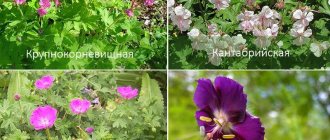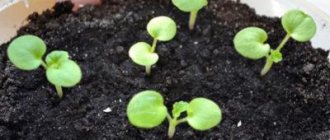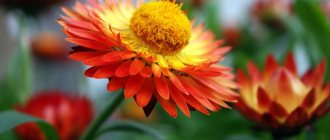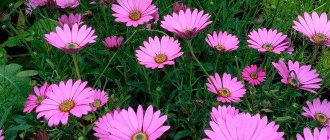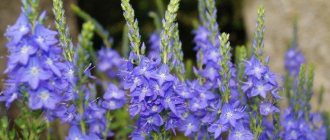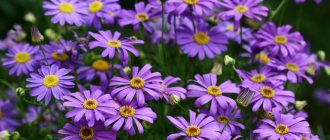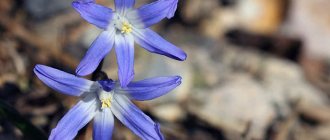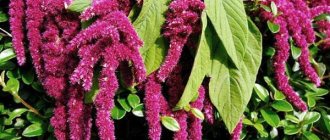A very unusual and quite interesting plant is kufeya. It grows wild only in America, or more precisely, in its southern and central parts. This unusual name comes from the Greek word “kyphos”, which translates as bent or crooked. Perhaps this flower acquired such an unusual name due to its curved fruits. On the lands of America you can find approximately 250 species of kufei, which also include annual subshrubs and shrubs.
As an annual garden plant, kufeya is grown by gardeners living in northern latitudes. However, this flower is also grown indoors. This plant can winter well in the southern regions, and it is most often grown there as a perennial shrub.
The flowering of kufei is quite long and it begins in March and ends only in October. During this period, its terry bushes become incredibly beautiful and sophisticated. Most often, this shrub is planted in fairly large vases or concrete containers are used.
From the seeds of an annual species of this plant, laurel acid is obtained, the use of which is found in chemical production. Gardeners began to grow this shrub quite recently, about 15 years ago. Breeders have developed about 10 new species of kufei.
What does kufeya look like?
Kufeya is an evergreen shrub with a lush fan shape. The plant belongs to the Derbennikov family. The shoots of the flower are erect, the leaf is of medium size, and is colored rich green.
Kufeya in landscape design
The cuphea flower is of Mexican origin. But the name has Greek roots and means “bend”. Externally, the plant fully corresponds to its name; the leaves of the kufei have obvious curves. It is generally accepted that if this plant blooms in a house, then peace and mutual understanding reign between the residents. For this reason, the flower is often placed in hotels, meeting rooms or other work spaces.
Important! The peculiarity of kufei is its inflorescences - their tubular shape resembles a cigarette with a smoldering tip.
This feature can be explained by the fact that in their homeland, kufeya is pollinated by the smallest birds in the world with a thin, curved beak - Hummingbirds. The plant blooms magnificently; this period lasts from spring until autumn. Throughout the warm period, houses, plots and window sills are decorated with magnificent kufei flowers.
Common types and varieties
The genus Kufei has more than 250 species, so you shouldn’t be too surprised if you see completely different plants under this name. Perennials can be not only of the bush type, but also of the herbaceous type, with erect or climbing stems. In Russia, they usually grow certain varieties that do well in any type of container.
Kufeya issopolis
Heuchera: planting and care in open ground
Kufeya issopolis is a species that has a special fresh appearance. These bushes reach half a meter in height.
The shoots actively branch, the leaves are small, the length does not exceed 3 cm, and are bright green. For kufei, such flowers are completely atypical.
The color of the inflorescences is lilac-pink, the petals are the same size, and there is a corolla with a diameter of 1 cm in the middle.
Important! These inflorescences do not produce seeds, so they can only be propagated by cuttings.
Kufeya Dynamite
Kufea Dynamite is a variety of hyssopolis kufea. This bush can be easily shaped by pruning to create the desired shape. For this reason, in addition to growing in containers, they prefer to plant the plant in open ground.
Abundant flowering in the warm season can truly decorate any, even the most unattractive, area. The shrub prefers warm weather, but winds and rains are not particularly scary for it.
Kufeya fiery red
In indoor conditions, the plant's growth reaches 40 cm, its stems are quite plastic. You can form it into an ampelous plant or a bush. The leaf has a smooth surface, elongated and narrow shape.
The inflorescences are elongated bright red tubes. At the end of these flowers there is a black-purple petal. Not only thanks to its inflorescences, but also to its unpretentious properties, the plant has taken root well in indoor cultivation.
Fiery red kufeya
Kufeya Gelya
This variety belongs to the fiery red variety. External data attracts many gardeners.
In a container, this plant grows beautifully and decorates balconies, loggias, offices and other rooms. Not only in containers, but also in flower beds, the kufeya variety Gel feels great. The plant can be planted in personal plots; it is usually used to decorate borders.
Botanical description
Kufeya is a small and compact shrub that blooms with beautiful flowers.
The plant belongs to the Derbennikov family (its representatives develop rather slowly). Shrubs that live in the wild for a long time can grow only 1.5 meters in length. Under natural conditions, kufeya is found in central and southern Africa, although the shrub is native to Mexico. The flower grows best in tropical and subtropical climates. The flowering of the plant lasts a long time - from the end of March to mid-October. Tubular flowers with six petals are formed in the axils or just above the emerald-colored leaves.
The colors of flowers can be very diverse:
- white;
- pink;
- red;
- lilac.
The diameter of the inflorescences reaches an average of 3 cm. Each flower has 6 petals, the top of which are the largest.
Each inflorescence has a short life, as they quickly wither. In order for new flowers to appear faster, wilted ones need to be removed in time. After flowering, small fruits of an original, slightly curved shape are formed in place of wilted inflorescences.
Important characteristics that kufei owners need to consider:
this is a perennial shrub, which in Russia, due to the climate, is grown as an annual crop; certain types of kufei grow very slowly; the plant lends itself perfectly to pruning and crown formation; for beginners in floriculture, it requires careful and regular care; from December to March it is important to arrange a dormant period, however, with sufficient lighting, kufeya can bloom all year round, but then the bush will not grow in height.
These rules are important to consider for everyone, especially a beginner gardener who wants to grow a healthy and beautiful plant.
Kufeya: planting and care in open ground
When it comes to planting in the garden, in Russia kufeya is usually cultivated as an annual plant. Because the roots can survive the winter season only if the temperature does not fall below -12 degrees. It is clear that the conditions of the Moscow region are in no way suitable for planting perennial varieties - winter will destroy the roots. But in the south of the country it is quite possible to try planting kufeya in the ground for several years.
- Choosing a landing site
Monarda - planting and care in open ground
When planning to grow kufeya in the garden, you need to choose an open, well-lit area. Unlike other ornamental crops, this flower tolerates direct sunlight.
- Planting in open ground
The plant is planted by transferring it into pre-prepared holes (humus must be added to them and dug well).
Allowable distance between individual bushes: at least 30 centimeters.
- Watering garden kufei
You need to make sure that the soil does not dry out.
The plant likes daily evening watering, when the sun is no longer hot, but has not yet set.
Attention! If you water flower bushes after sunset, rot may appear.
- Need for fertilizers
If, when planting a plant in open ground, organic matter was added to the soil, then fertilizing may no longer be carried out. If, for some reason, the planting holes were not properly prepared, then fertilizer will need to be added for abundant flowering.
A couple of weeks after planting, they are fed with nitrogen fertilizers. When the buds begin to form, it would be good to add phosphorus-potassium substances.
Description
Part of the Derbennikov family, kufeya lives in the subtropics and tropics of South and Central America. Mexico is considered the original homeland of the plant. Compact, with small openwork leaves and abundant flowering, it grows slowly and for a long time.
Both in our climate and at home, its height does not exceed 40–60 cm. The flowers are rod-shaped (see photo), their color is dominated by rich, as if luminous, red and purple tones.
Frost resistance of kufei
The weak level of frost resistance does not allow perennial plant species to be grown in the garden. The heat-loving flower hardly survives even mild winters with frosts not lower than 12 °C. That is why only annuals are cultivated in open ground.
Perennial varieties of kufei are chosen for the home, decorating verandas and flower beds in the summer with bushes sitting in pots. You can keep them outdoors until September, then you should return them to the house.
Kufeya: features of care at home
This plant can be called truly demanding and capricious. For this reason, if novice gardeners get down to business, growing and caring for kufei often brings complete disappointment. If basic care rules are not followed, the leaves of the flower will immediately begin to turn yellow, after which they will fall off and the bush will become bald. With poor care, flowering is difficult to achieve, and it will not be as abundant as we would like.
- Temperature
Nasturtium planting and care in open ground
The plant loves warmth, but in moderation; it needs normal air heating.
In summer, the temperature should not be higher than 25 degrees, and in winter, when the rest period begins, around 19-20 degrees Celsius.
- Lighting
In order for the bush to develop vegetatively according to all standards, it needs a normal amount of sunlight.
It is best to place the container with the plant on the east side of the house. Western windows are relatively good; wintering on them is acceptable.
Important! Growing on northern windows is unacceptable - due to the lack of sunlight, flowering will be poor and the leaves will become dull.
- Watering
At any time of the year, watering kufei as care at home is the same. The plant prefers a good amount of moisture every 3 days. Between waterings, do not allow the substrate to dry out completely. The flower tolerates drought normally only in open ground conditions.
- Spraying
You can and even need to spray kufeya. The flower needs irrigation at least 3 times a week. The description of the variety speaks of its special love for humid microclimates.
Growing kufei in a container
- Humidity
The plant loves high humidity levels. For this reason, you should not keep it in a room with dry air, and if there is no other option, you should take care to spray the plant frequently.
- Priming
The soil should be nutritious and well drained. A store-bought mixture with weak acidity is quite suitable.
- Feeding
Fertilizers should be applied once every 2 weeks. Complex preparations with fluoride and potassium are suitable.
When and how does kufeya bloom?
The flowering period of kufei can be quite long if all the rules of agricultural technology are followed. Good care will give abundant flowering.
- Types of flowers
The appearance of the flowers depends entirely on the type and variety of kufei. The corollas can be painted not only brick red, but also creamy white.
Important! Red flowers are the earliest to form.
- Flower shapes
The shape of the flowers is tubular with a dark tip; it is the most common and resembles a kind of light. The second most popular form is an inflorescence with petals of the same size and a pronounced pistil.
- Flowering period
This plant blooms from March to October. For almost six months, the plot or loggia will be decorated with beautiful flowers.
- Changes in care during the flowering period
During the growing season, pruning should not be carried out under any circumstances. Watering is reduced slightly, but the soil should not be allowed to dry out. Don't forget about applying fertilizers.
Attention! You should not use formulations with a large amount of nitrogen, otherwise only the green crown will actively grow.
Pruning kufei
Pruning must be done every spring. At this time, it will be possible to give the crown a good shape and the desired size.
- The fiery red kufeya needs to be pruned so as to shorten only the long branched shoots.
- Kufeya hyssopolis will have to be shaped much more carefully to make an attractive crown.
In the last days of March, 2/3 of the shoots should be removed, this is how growth and vegetation are stimulated.
Formed kufei bush
How does kufeya reproduce?
Kufeya propagates using cuttings and seeds. If any of the propagation methods has produced a strong and healthy plant, it can be safely planted in open ground.
Germination of seeds
Instructions for sowing seeds:
- The seeds of the plant are stiff and have poor germination. The seed material is laid out on the soil surface. You don’t need to cover them with soil, you can just press them a little into the ground.
- The containers must be covered with film and placed in a warm place.
- Abundant but infrequent watering is carried out.
- Picking should be carried out after the appearance of the fifth leaf.
Rooting cuttings
It is better to cut cuttings for propagation in late spring. They can be successfully rooted using phytolamps.
The main thing is that there are at least 2 nodes on the cutting. To begin with, the cuttings are planted in sand and the container is covered with film. Don't forget about watering.
After rooting, the cuttings can be safely planted in different containers.
Air layering
Those varieties of kufei that have air layering can be propagated with their help. To do this, it is important to cut off the desired area of the shoot, treat it, moisten it and wait until roots appear in this place.
The cuttings are cut at a distance of 1.5 cm below the cuff and planted in the substrate.
For reference: this method of propagation is practically not used for kufei.
Subtleties of reproduction
Traditionally, the fastest and most effective method of propagating kufei is used - cuttings. In this case, cuttings up to 15 cm long are cut from the tops of the shoots in early March. Often, planting material is obtained after pruning. The branches are planted in loose and well-moistened soil and sent to a room with an air temperature of +18˚С. A cap in the form of a plastic bottle with an open neck is put on the container. The cover is removed for watering and ventilation. As soon as a few leaves appear on the seedling, it is transplanted into a pot.
Rooting is often carried out in a glass of water. To obtain the most decorative flowerpot, 2-3 cuttings are planted in one pot at once.
Growing Kufei Gel from seeds is a more painstaking method of propagation, because the germination rate of planting material is low. Nevertheless, seeds are sown in a container with an air- and moisture-permeable substrate. They are slightly pressed into the wet soil, but do not go deep. The container is covered with film or glass. Germination is carried out at a temperature of +22˚С. The mini-planting is sprayed and ventilated daily. The cover is removed when the first shoots appear. As soon as the seedlings grow up and have 2-3 full leaves, they are transplanted into separate pots.
With proper care of the kufei, the gardener can count on a healthy and beautiful flower. Then this representative of the tropics will delight everyone with its long and luxurious flowering.
Possible problems in growing kufei
If you follow all agrotechnical rules for growing kufei, no special problems should arise. But if care does not meet the requirements, the flower begins to give signals, its external characteristics become unattractive.
Yellowed leaves
- Drops buds and leaves
This reason may occur due to insufficient sunlight. At best, flowering will be sparse; at worst, the plant will independently shed the established buds.
- The leaves are turning pale
If the leaf turns pale or yellow, there are two solutions to the problem. In this case, it either lacks iron, or the watering was carried out too abundantly or often. It is worth reducing watering and adding the necessary fertilizers.
- The tips of the leaves are drying out
In this state of affairs, we can talk about insufficient watering, or the presence of strong drafts. It is necessary to increase watering, after it there should be water left in the pan, after 10 minutes it needs to be drained. If drafts are a concern, it is better to move the pot to another place and carry out sanitary pruning.
- The lower leaves fall off
In addition to the falling of the lower leaves, they may also become covered with brown spots. Most likely, the root collar is rotting. The plant suffers from a fungal disease; urgent treatment with fungicides and sanitary pruning are required.
Pests
In rare cases, kufei is attacked by scale insects and spider mites. If there are mites in the container, then a characteristic thin white web can be observed on the plant. In such a situation, it is enough to treat the plant with a sponge soaked in a soap solution. If the case is advanced, then chemical treatment will be required.
If convex brown tubercles are found on the leaves, then we can talk about the appearance of a scale insect. A soap solution and a brush will help mechanically get rid of such insect shells. Additionally, insecticidal treatment can be carried out.
Kufeya in the garden
If you properly care for your exotic kufeya, no problems should arise with it. Beginner gardeners should not take on growing a flower; they may not be able to cope with this plant, because caring for it is not so easy. We must not forget about watering, fertilizers and mandatory pruning, then for many months you can expect beautiful flowering of the shrub.
Pests, diseases and possible problems
- Kufeya can be affected by aphids and spider mites. Treat it with an insecticide.
- The plant may rot if it is systematically overwatered.
- Leaves may fall if the kufeya is in a draft.
- Gray spots on the leaves may indicate the appearance of a fungus or gray rot - cut off the affected parts and treat the plant with a systemic fungicide.
- Kufeya is prone to chlorosis - if its leaves turn yellow but remain elastic, pour it with iron chelate, or even better, spray it over the leaves.
Difficulties in growing kufei
When growing this plant, problems can arise when the soil is flooded and there is high humidity, then dark spots appear on the stems and leaves, which are caused by gray rot or various fungal diseases. If such symptoms are noticed, then treatment with fungicidal preparations should be carried out. Among the pests that plague kufei are whiteflies, spider mites or aphids. If a pest is detected, the foliage should be sprayed with insecticidal agents. If the plant is exposed to a draft, this may cause leaf loss.
Some tips
- Fertilize the soil with organic fertilizers. In this case, the kufeya will reach its maximum size at the beginning of summer.
- Don't be afraid to trim your bushes regularly. This only makes it thicker and more magnificent. You can prune kufeya at any time of the year. Designers successfully use this and form intricate plots from the crowns of bushes.
- Plant the sprouts at a distance of at least 35 centimeters from each other.
- If dark spots suddenly appear on the leaves, then know that the roots are affected by a fungus. This happens due to excessive watering or prolonged rains. In this case, the plant can be saved by using fungicidal preparations. These products can also combat powdery mildew.
- Sometimes the cigarette tree is affected by spider mites, thrips and scale insects. You can get rid of spider mites using a soap solution. After removing the insect placenta, be sure to spray the bush generously with water. A solution of potassium soap or insecticides will help against scale insects and thrips.
- And finally, a very important tip. Under no circumstances should you plant kufeya in places where there are drafts. Under their influence, the plant sheds its leaves.

